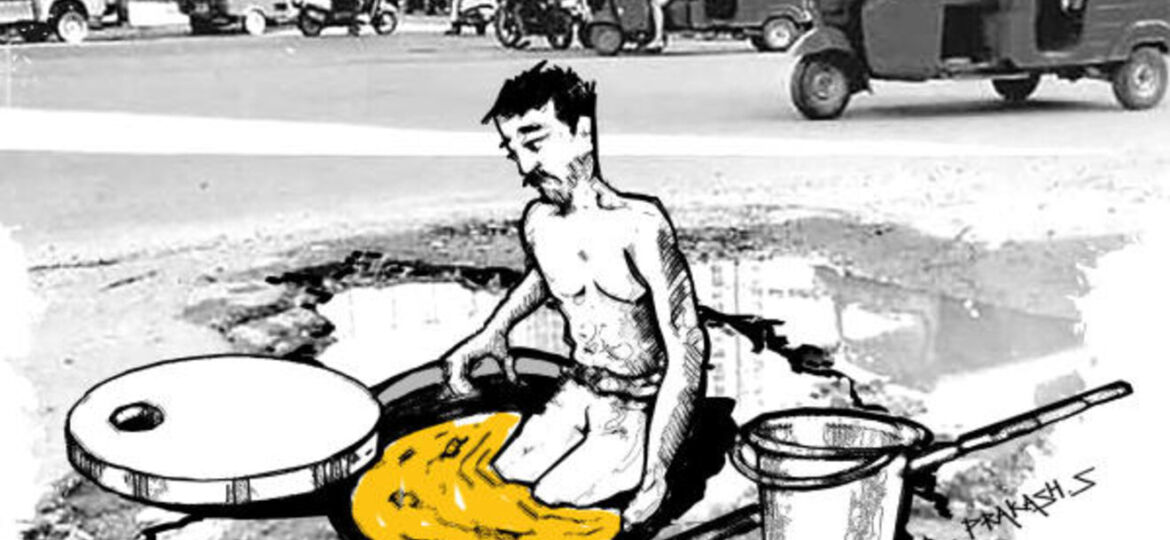
INTRODUCTION
Manual scavenging refers to the practice of manually cleaning, carrying, disposing, or handling in any manner, human excreta from dry latrines and sewers using basic tools like baskets and brooms. It is an extremely unsanitary job which spreads diseases and infections to scavengers. This practice is connected to the caste system of India, meaning that it is only the people from the lower castes who perform this job. The inhumane and discriminatory nature of this practice led the three organs of the government – the legislative, executive and judiciary – to intervene at multiple instances to end this practice. However, despite these interventions, manual scavenging still prevails in India, which makes us question the nature of the actions taken by the authorities.
INTERVENTION BY LEGISLATIVE, EXECUTIVE AND JUDICIARY
The practice of manual scavenging has been prevalent in India since time immemorial. Many people like Mahatma Gandhi and Prime Minister Narendra Modi, while talking about manual scavenging have referred to it as “one of the most honorable among the occupations” and a “spiritual experience,” respectively. However, a more accurate description would be the one given by Dr. B.R Ambedkar who stated that a man is not a scavenger because of the work, he is one because of his birth or, in other words, his caste. The caste system is based on the concepts of descent, endogamy, pollution and purity, which, as opposed to class, does not allow any upward movement for people of the lower castes. It has been called as one of the worst violations of human rights.
Manual scavengers remain victims of discrimination in India, despite numerous constitutional safeguards. Article 17 of the Indian Constitution prohibits untouchability, which is another malpractice which stems from the caste system. However, the practice of manual scavenging, which has been called the worst surviving symbol of untouchability, still persists. This work is one which has washed people from the lower castes off their dignity and has historically led to only injustice. The right to dignity is an inalienable right under the fundamental right to life enshrined in Article 21,[i] which manual scavengers are not subject to. Furthermore, the discrimination based on caste faced by these scavengers goes against Articles 14, 15 and 16 of the Constitution as well.
In the year 1993, the Parliament enacted the Employment of Manual Scavengers and Construction of Dry Latrines (Prohibition) Act, 1993 for the bringing about a halt to the practice of manual scavenging. This Act remained inoperative till 1997 when it was applied to some States and Union Territories. Despite this, there was not much decline in the practice of manual scavenging. This Act was highly criticized for being inadequate because of which the government in 2013 enacted the Prohibition of Employment as Manual Scavengers and their Rehabilitation Act, 2013. The 2013 Act was put in place to end the practice of any form of manual cleaning, carrying, disposing, or handling of human waste. Even though the government realized the issues underlying such a horrific practice, the lack of implementation of the provisions of this Act makes one question as to whether the government did treat this practice as an actual problem. This non-implementation of the 2013 Act was tackled by the Supreme Court in Safai Karamchari Andolan vs. Union of India,[ii] where the State Governments and Union Territories were directed to take appropriate actions for the non-implementation and violation of various provisions of the Act.
WHY MANUAL SCAVENGING CONTINUES TO PERSIST
Despite the multiple interventions by the Center and the Supreme Court, the practice of manual scavenging has in no way been abolished. A national survey conducted in 18 States had identified 48,345 manual scavengers till January 2020. As many as 282 people had died while cleaning sewers and septic tanks in the country between 2016 and November 2019. The official counts have reduced drastically, however this change stems from the underassessment and shortcomings of surveys and cannot be construed as the actual number. This was proved when the Safai Karamchari Andolan conducted its survey in 2018, where it identified 87,913 manual scavengers in 14 States, of which only 42,303 were recognized by the ministry and 27,268 had been integrated into relevant schemes and had received any form of entitlements or benefits from the government.
One of the biggest reasons why the practice of manual scavenging remains alive is that the laws prohibiting it are made and implemented by people of the higher caste. Despite affirmative actions of reservations under Article 15 of the Constitution, people from the lower castes hardly get opportunities to work in either the Centre or the Courts. Even today, the number of Dalit judges in the Supreme Court is in the low single digits. The number of MPs is also extremely low as not a single constituency in India has more than 50 per cent Dalit population, because of which it’s always the non-Dalits who decide the fate of Dalit candidates in reserved constituencies. Due to these reasons, the laws surrounding the issue of caste, where people from the lower castes are the ones suffering, are made by those from the higher castes. The people actually suffering are not consulted in this matter, due to which the authenticity of knowledge surrounding the problems of this practice reduces, and the laws end up being made through a savarna gaze.
Dr. B.R. Ambedkar was of the view that Indians had a primary fidelity to their caste.[iii] Prior to him, a French diplomat – Alexis de Tocqueville had once stated, “The national spirit of Hindus is trapped within the caste.”[iv] But in certain cases, for those high caste Hindus, it is easier and more convenient to pretend that they do not believe in or have a caste, while continuing to reap the benefits, material and intellectual, overtly as well as covertly, through the power of their given names and caste networks. The Delhi government, for example, had claimed to have eradicated this practice completely, which was found to be untrue after conduction of surveys. This constant denial can be construed as intentional as this practice is a consequence of the casteist structure of the Indian society, despite which, the word ‘Caste’ is not used in the 2013 Act. Furthermore, in Delhi Jal Board vs. National Campaign for Dignity & Rights of Sewerage & Allied Workers,[v] the Supreme Court criticized the government and the State apparatus on being insensitive to the safety and wellbeing of those who are, on account of sheer poverty, compelled to work under most unfavorable conditions and regularly face the threat of being deprived of their life and directed the Government to ensure the safety and security of these workers. The verdict in this case failed to call this practice an issue of the caste system and talked only about their class. This lack of acknowledgement of the caste system is of another reason why this heinous practice of manual scavenging persists in India.
The central government recently announced that a new Act is in the run to put an end to the discriminatory and hazardous practice of manual scavenging by August 2021. The need for this new legislation proves that the Acts of 1993 and 2013 have failed, both in its policies and implementation. However, this new bill seems to be going on the same path as it simply reemphasizes the contents of the previous Acts. Moreover, instead of focusing on the rights of the manual scavengers and completely prohibiting this practice, fails to learn from the previous Acts and focusses only on safety gears. It once again fails to acknowledge this as a caste issue and does not take into consideration the problems of people actually suffering from this practice.
CONCLUSION
It is apparent that the legislative, executive and judiciary have tried to put an end to the practice of manual scavenging from a long time now, but they keep falling prey to the same vicious cycle since 1993. There have been numerous legislations and case laws which have not seemed to have done the job of abolishing this practice. The main reason for this is that the authorities refuse to dig deep and attack this problem to its roots which is the caste system. Till the time that does not happen, and people keep denying its existence, the practice of manual scavenging will keep haunting over India, no matter how many laws we introduce.
Author(s) Name: Anshita Sethi (Jindal Global Law School, Sonipat)
[i] Maneka Gandhi v. Union of India, AIR 1978 SC 597
[ii] (2014) 11 SCC 224
[iii] B R Ambedkar, Annihilation of Caste: The Annotated Critical Edition (Navayana 2014)
[v] (2011) 8 SCC 568
















